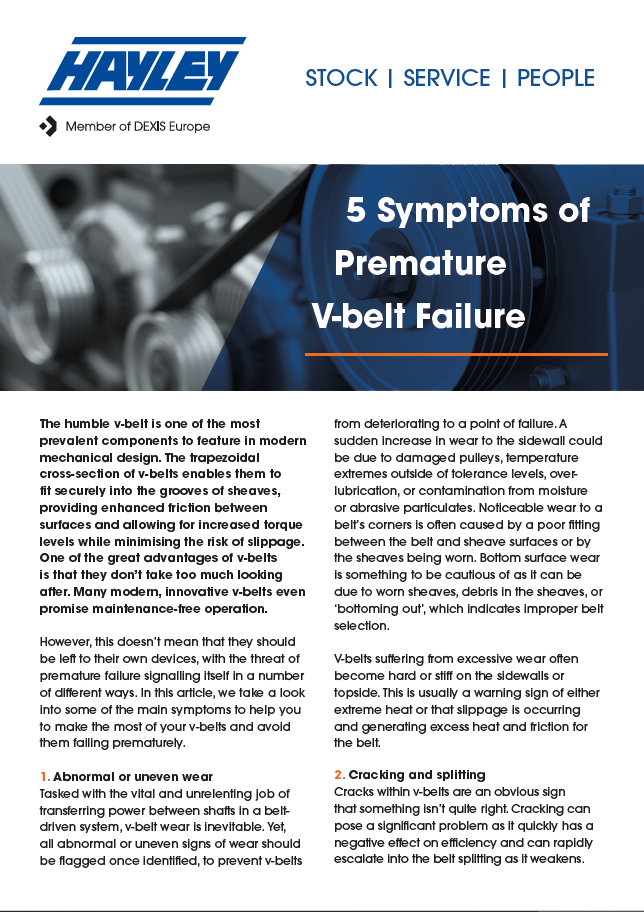The humble v-belt is one of the most prevalent components to feature in modern mechanical design. The trapezoidal cross-section of v-belts enables them to fit securely into the grooves of sheaves, providing enhanced friction between surfaces and allowing for increased torque levels while minimising the risk of slippage. One of the great advantages of v-belts is that they don’t take too much looking after. Many modern, innovative v-belts even promise maintenance-free operation.
However, this doesn’t mean that they should be left to their own devices, with the threat of premature failure signalling itself in a number of different ways. In this article, we take a look into some of the main symptoms to help you to make the most of your v-belts and avoid them failing prematurely.
1. Abnormal or uneven wear
Tasked with the vital and unrelenting job of transferring power between shafts in a belt-driven system, v-belt wear is inevitable. Yet, all abnormal or uneven signs of wear should be flagged once identified, to prevent v belts from deteriorating to a point of failure. A sudden increase in wear to the sidewall could be due to damaged pulleys, temperature extremes outside of tolerance levels, over-lubrication, or contamination from moisture or abrasive particulates. Noticeable wear to a belt’s corners is often caused by a poor fitting between the belt and sheave surfaces or by the sheaves being worn. Bottom surface wear is something to be cautious of as it can be due to worn sheaves, debris in the sheaves, or ‘bottoming out’, which indicates improper belt selection.
V-belts suffering from excessive wear often become hard or stiff on the sidewalls or topside. This is usually a warning sign of either extreme heat or that slippage is occurring and generating excess heat and friction for the belt.
2. Cracking or splitting
Cracks within v-belts are an obvious sign that something isn’t quite right. Cracking can pose a significant problem as it quickly has a negative effect on efficiency and can rapidly escalate into the belt splitting as it weakens.
The most common cause of cracking, especially to the underside, is that the v belt’s material composition is unsuitable for the high temperatures that it is being exposed to. Pulleys being too small or misalignment can also lead to cracking on the underside of v-belts.
Splitting of v-belts or separations in the belt body and/or ribs is often a tension-relation issue that originates in installation. Forceful fitting of an unsuitable v-belt or running it with the incorrect tension is regularly to blame for splits and separations. The manufacturer’s guidelines should always be followed when mounting and adjusting the tension of a belt to avoid running into future problems.
Separations in the belt body and ribs could also be caused by solid debris wearing one section of the belt more than others until it reaches the point where the rib peels from the belt’s base. Immediately replace any belt displaying these deformities and ensure that the new v-belt is correctly positioned on the pulleys, as well as checking for foreign objects capable of damaging your belt and the components around it.
3. Hardened or polished edges
If a v-belt shows signs of hardened edges or its surfaces appear polished, preventative action needs to be taken. These symptoms are often down to misalignment of pulleys, or the configuration or installation of the belt set is wrong. Follow manufacturer’s installation instructions closely and use an alignment tool to ensure accuracy when fitting.
4. Failure to carry load
If a belt begins to falter in its ability to carry its load, it will begin to slip. The cause of this is that the drive is often not sized correctly or there is insufficient tension in the belt. Worn sheave grooves and damaged tensile cords within the belt could also be to blame. As the load-bearing component of v-belts, the strength rating of tensile cords should always be a good match for the load that they are carrying. Severe shock loads can also result in tensile cord damage, so this is also a consideration for the v-belt selection process. In many premium v-belts, tensile cords are often bonded to the belt’s rubber body, creating a single unit that helps to distribute load and prolong the service life of the belt.
5. Excessive noise
Having an understanding of the sounds and noise levels emitted by your belt drive can also help you to diagnose problems. Excessive or abnormal noise is a good indicator that something is wrong, and action needs to be taken. A chirping sound is often reported in belt drives where the ribs of the belt slide down one side of the pulley grooves. To remedy this, check the alignment of all drive components. Laser alignment tools are the optimal way to ensure accuracy during installation and avoid excessive noise, wear and belt routing problems. Precision is key here, because as little as one degree of misalignment is detrimental to the lifespan of a v-belt.
Hayley Group has hundreds of thousands of power transmission products, including a full range of v-belts, in stock for same and next-day delivery. Our stockholding is enhanced by the expertise of our staff and the support of market-leading v-belt manufacturing partners such as Gates®, Ammeraal Beltech, Optibelt, and Megadyne. Speak to your local Hayley team to enquire about any belting or general power transmission requirements! Find their details by using our online Branch Finder tool.



